(Not) Selling Books to Kids

I sold books at the Amherst Artisan’s Market today. A little blond girl stopped by my vendor table and was very taken with the cover illustration on Better Angels: Tour de Force. I did my regular pitch:
I call this “fluffy military space opera”. It’s about a group of non-human biological androids that look like pre-teen girls and act as a magical-girl singing-and-dancing troupe, but they can change up their programming and become a covert military force.
“That sounds fantastic!” the girl said.
“I should tell your mother,” I said, “that although this book doesn’t have adult themes, it does have some violence. The contrast between the Angels being cute little girls and ruthless killers, when they turn on their soldier programming, is what the Japanese call ‘gap-moe’ and is what I was going for as an author.”
“Oh, violence is just fine,” the girl said. “I read that all the time.”
“But do you have ten dollars?” her mother said.
The little girl’s little sister piped and said, “She has a HUNDRED DOLLARS.”
“No, she doesn’t,” her mother said.
“But, Mom!” the little girl protested, as her mother dragged her away.
I almost wanted to say, “Sorry, Brunhilde!”
What’s In Your DNA?
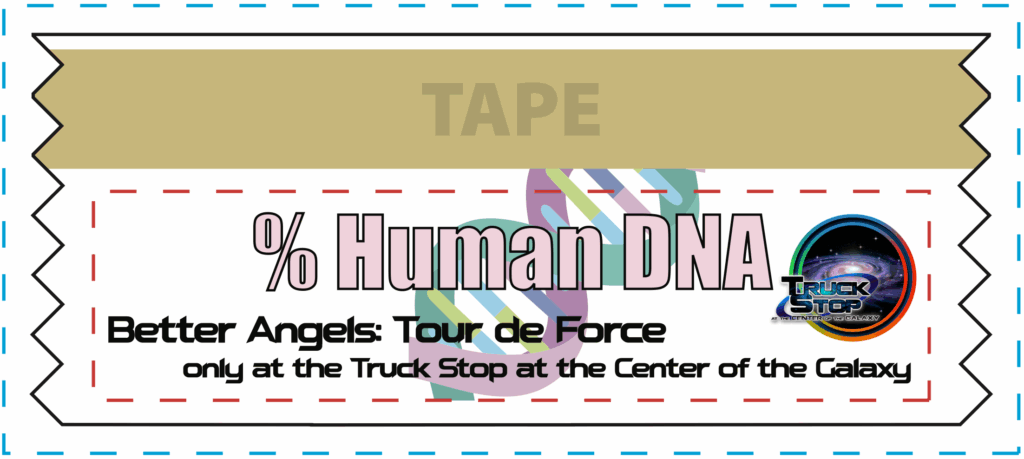
When I attended my first WorldCon, I created some Airship Pirate ribbons to promote the serialization of Revin’s Heart. It was (from my perspective) a wildly successful promotional campaign. It was a huge amount of fun, gave me an ice breaker to discuss my book as people walked by the table in the dealer room, and was surprisingly (to me) gratifying to see dozens of strangers all over the convention wearing my ribbon. Since then, I’ve thinking about what I could do to meet or surpass the standard I set then. I think I may have done it with a new ribbon to promote the Better Angels.
The Better Angels are non-human biological androids. That means that they have no human DNA — they are the product of clean-room biological engineering. They are molecularly assembled to spec, fully grown (well, as pre-teen girls), and have a personality module that has programming to govern their behavior. So, although they look like pre-teen girls, they are not human. They were not born. They don’t grow or develop. And they are programmed with a stack of modules that provide all of the functionality for their behavior, from basic autonomic physiology to language and higher-order behavior. In the case of the Angels, they can be singing-and-dancing pop idols or ruthless, cold-blooded covert-military soldiers (Or more! Read the stories to see what else they can do!)
This time, I’ve created a ribbon people can wear with a space to write in their percentage of “human DNA.” You might ask, “How do you know your own percentage of human DNA?” What a great question! To answer that question, I’ve created an app (well, just a webpage, actually) that analyses your DNA and tells you what percentage is “human.” The Better Angels, of course, have zero percent “human DNA”, but how much do you have? Luckily, the app can tell you!

The 任せて Human DNA Analysis app is simple to operate. You scan a QR code to open the app on your mobile device and tap the fingerprint icon on the screen. The app runs, emits several progress messages, and finally reports your percentage of “human DNA”. Sometimes the first time it runs, it may give you anomalous results. But if you run it a second time (or more), it gives you “more accurate,” precise, and consistent results.
Note the disclaimer at the bottom of the page, however: “Accuracy of 任せて DNA Analysis ±100%”
Also note that, yes, of course I could link the app here. But you’re going to have to come visit me in the dealer room to get the QR code. (smiley-face)
I used to write little web apps like this all the time. For most of my career, I was the Director of the Biology Computer Resource Center at UMass Amherst. I created dozens little web apps for teaching or infrastructure for the Biology Department. But I haven’t done anything like that for a few years. I had to solve a variety of minor technical problems to make it work, and I was tickled to find that I haven’t completely lost my touch.
I invested a fair amount of time investigating what to use as a plausible value of percent human DNA. The simplest answer would have been 99% or something like that. But that wouldn’t have given me a context to talk about the structure of the human genome, which is delightfully weird and complex.
Most people know there are these things called “genes.” And a lot of people know that genes contain the “code” for proteins. When Francis Crick and others “cracked the genetic code” there was great optimism that we would quickly be able to read the “blueprints of life.” But genomic structure turned out to be way, way, way more complicated.
It turns out that only a tiny part (1%-2%) of the DNA in your genome contains coding sequences to make proteins. There are lots of other sequences in there, many of which are still only poorly understood. Each coding sequence is paired with regulatory sequences that control when it is transcribed. There are also bits that code for RNAs that aren’t translated into proteins (transfer RNAs, etc). As much as 8% of your genome includes human endogenous retroviral sequences. Retroviruses (like HIV, varicella-zoster (aka chicken pox), and herpes) have been sticking their DNA into eukaryotic genomes for billions of years. Then there are structural and repetitive sequences, that include things like centromeres, telomeres, and microsatelites, that may comprise as much as 50% of your genome.
Humans are primates and mammals and tetrapods and vertebrates and eukaryotes. The amount of “uniquely human” DNA is actually vanishingly small. Almost all of our genes are literally identical with bonobos (our closest primate relatives) and are functionally identical with all mammals and tetrapods and eukaryotes. Some proteins (like ubiquitin and cytochrome C) have been honed by billions of years of evolution and are virtually identical across all living organisms.
In the end, I met with a couple of professional biologists to ask them what percentage I should report as “human DNA” with the goal of being able to tell a fun story about genomic structure. They were pretty amused by the idea, once they got past the science fictional elements (One said, “What! They don’t go through development!?”), and we agreed to pick something something around 60%.
The ribbons are currently scheduled to be delivered in time that I should have them for Readercon! And I will bring plenty to Worldcon. (Well, a goodly number, anyway. These things don’t grow on trees, after all.) I’m excited, because I suspect they’ll be a hit and, when people see others wearing them, they’ll want to stop by the table to get one of their own. And, who knows, maybe even pick up a book!
So if you’re coming to Readercon or Worldcon, come find me at the Water Dragon Publishing table and get your DNA analyzed.
Seattle Worldcon 2025 Schedule

The final(ish) Schedule for Worldcon has come out and I am on the program! My experience with Worldcons seems to be either feast or famine. I had eight appearances as a participant in Chicago, for my first Worldcon, and then was totally declined as a participant for Glasgow. This year, I’m excited to moderate one panel, appear in six more, and I also have a reading. Here is my schedule in chronological order.
Can Biological Research Ever Be Independent?
Room 447-448, Wed. noon–1 p.m.
Let’s face it, we conduct science in an inherently for-profit environment, which leads to all sorts of biases. How do we work around these built-in barriers to create truly independent science? Without breaking too many laws, of course.
An Hour of the Strange, Unusual, Creepy
Room 343-344, Wed. 3–4 p.m.
Ewww! Gross! WTF? Yep, all of this stuff is real… and some is common in your back yard.
Self-Publishing for Poets
Room 445-446, Thu. 10:30–11:30 a.m.
From chapbooks to zines, poetry has a rich history of self-publishing. Whether your goal is merely to get your poems into more hands or to craft an online presence as a poet, this workshop will help you learn how to market, sell, and self-publish your poetry. From blogging to Instagram to Amazon, we’ll dive into the important details of crafting a bestselling poetry collection. Learn how to format poetry, how to find the best distribution sites for poetry books, and how to market a collection from advertising to book reviews.
Life as We Know It
Room 447-448, Thu. 1:30–2:30 p.m.
Nothing in fantasy or sci fi is original (no, don’t rage-quit); it is all amalgamations of things we have seen or heard of. So would we recognize life that is truly alien?
Human Evolution and Our Influence on It
Room 445-446, Thu. 3–4 p.m.
Just because we’re at the top of the food chain doesn’t mean that humans are done evolving. Can we predict what is in the future for our bodies? Which creators’ visions are realistic?
Biology and Evolution of the Dog
Room 447-448, Sat. 9–10 a.m.
Human’s best friend, best creation, and best companion: What was the evolutionary path of the household dog? Was humanity the worst thing to happen to wolves?
Makerspaces: For When You Can’t Own All the Tools
Room 335-336, Sat. 6–7 p.m.
A makerspace is shared workshop or group of workshops where people can use the tools and facilities to work on their own projects. Some are membership-based, and some are in public libraries. Assume that any major city will have at least one. Our panelists will discuss their involvement with makerspaces, what they recommend, and how the user can get the best experience from a makerspace.
Reading: Steven D. Brewer
Room 429, Sun. 9–9:30 a.m.
A Familiar Problem. Becoming a powerful demon’s familiar might just be the best thing ever. But what’s the catch? Rory Soletsa is supposed to find his magical familiar, but he doesn’t want something trite, like a cat; or stupid, like a bird; or ugly, like a toad. Amazed when he is captured and becomes the familiar to a powerful demon who presents as a voluptuous, beautiful woman, Rory discovers how much more powerful his magic is with her. And he’s ecstatic when the demon tells him she will train him in advanced offensive and defensive magic. But just what is she training him for?
LOSCON 51

For several years, I’ve considered attending LOSCON in Los Angeles. This year, I’m going to go!
A few years ago, I was accepted as a participant, but due to my health circumstances at the time, I declined. I was still recovering from being hospitalized and was only attending conventions where masks were required. Now, almost no conventions still require masks. (Readercon, next weekend, is a welcome exception!) And I have recovered from my hospitalization. Well… As much as I am going to recover. So I’ve decided to apply to LOSCON again.
I’m particularly interested in attending this year because next year’s Worldcon is also going to be in Los Angeles. Many of the relevant people will undoubtedly be at Worldcon this year too (which I’m also attending). But it will be a chance to meet the LA folks specifically.
They asked for proposals for panels, so I drafted one that I haven’t seen at conventions before.
Poetry and Songs in Speculative Fiction
One of the enduring traits of Tolkien was his use of poetry, rhyme, and song as essential characteristics of his world building and the lore of the world he created. This panel will explore innovative uses of the lyrical arts to enhance speculative fiction and some of the challenges of adding this dimension to your works.
I hope the panel is accepted. Many of my own stories have had examples of music and/or poetry (e.g. Better Angels: Tour de Force, Something Else to Do in Modern Magic, and others). I think it would be fun to put a panel together to get authors to talk about the topic.
LOSCON takes place over the Thanksgiving holiday weekend. I’m looking forward to going!
Disability Pride Month and Representing Disability in Fiction
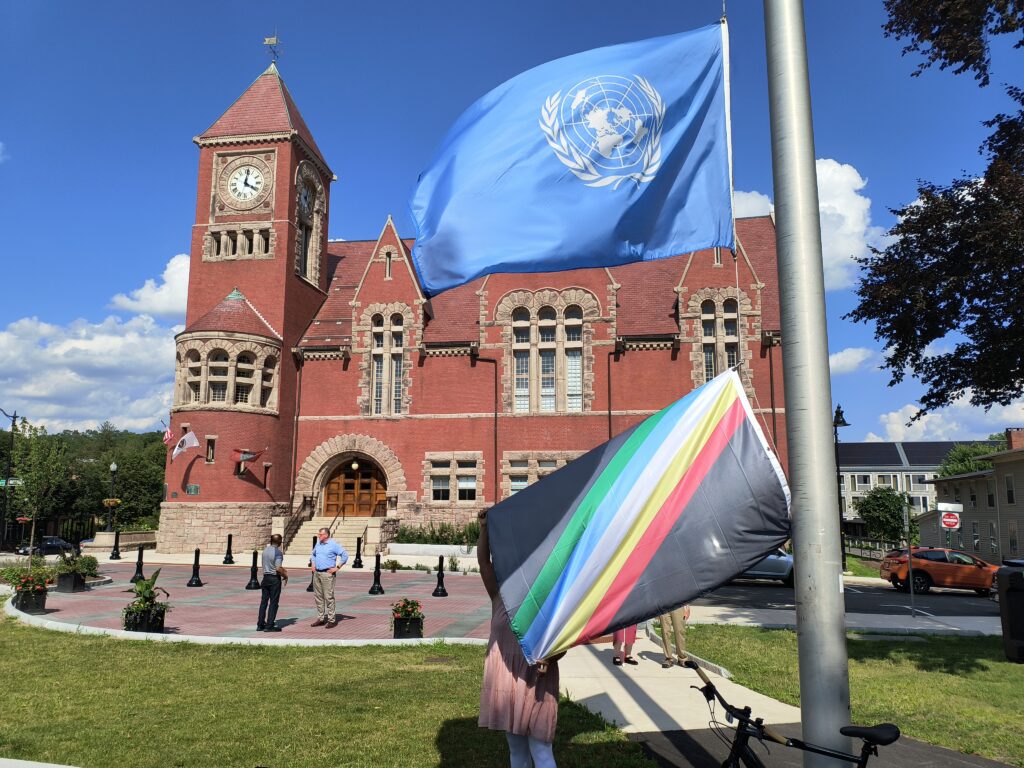
Representing disability is important in fiction. Many years ago, I saw someone who said that, rather than calling some people “disabled,” we should call everyone else “temporarily abled.” Because if you don’t have a disability now, you will. If you live long enough, almost everyone will go through some period of their life with a disability: a broken foot, gout, a bout of depression, etc. After I was hospitalized, I discovered that I have a disability: a chronic lung condition that limits my life in significant ways.
Today, my wife and I attended a flag raising for Disability Pride Month. The Town Council of Amherst wrote a proclamation and raised a flag to recognize and celebrate people with disabilities. And to commemorate the passage of the Americans with Disabilities Act, which has been transformative for ensuring access for disabled people. It was an opportunity for to me to reflect on the writing I’ve done representing disabled characters. I have several stories that represent characters with disabilities, both physical and mental. But one character stands out.
One of my favorite characters in the Revin’s Heart series is the Professor. Revin’s first meets him when he sees a glider fly from the mountain top of the island where the pirates have their base and land on the beach.
[The glider] skidded to a stop, and then flipped over. Revin, with his sharp eyes, could see someone strapped into the device with a harness.
Revin sprinted down the switchbacks of the trail to the sea. A few of the most athletic pirates got ahead of him by running straight down, bypassing the switchbacks. But five or six of them arrived at more or less the same time to see the man — for they could see now it was a man — with wild white hair and a gray beard scramble out of the harness. But Revin could see something was terribly wrong. The front half of him was crawling out of the harness, but he was leaving his legs behind.
“Aaaa! What’s happened to your legs?” Revin asked in shock.
“Those aren’t my legs,” the man growled. “Those are just for balance.”
“But you don’t have any legs! What happened to your legs?” Revin persisted.
“Airshark got ’em,” the man replied, gravely. “Have you ever seen an airshark? Terrible creatures.”
Revin was dubious. He started to open his mouth, then realized that all of the pirates were standing in a circle, watching his facial expressions, and trying not to laugh. He turned bright, bright red and they exploded with laughter, rolling on the ground. Gently hazing the new cabin boy was a popular pastime among the pirates. And now the strenuous efforts of the pirates to get there ahead of him were explained.
The backstory of how the Professor came to not have legs is never described in the books. Revin discovers soon, however, that the Professor brilliantly supervises the team of pirates that maintains the airship and keeps it airworthy. He uses hand-braces to move around and is clearly a genius inventor, scientist, and engineer. He’s blunt, plain-spoken, and gruff, but you soon learn that he really cares about Revin and the other pirates.
Grip […] sent Revin to the Professor to request he construct a practice sword with similar properties to the real sword. He looked at the sword, then looked at Revin fiercely from under his bushy eyebrows.
“You’re going to get yourself killed if you play with these things,” he grumbled.
“I want to be able to protect my friends,” Revin said.
“Worry about yourself first,” the Professor said. “You can’t help anyone if you’re dead.”
“Please?” Revin said, sweetly.
“Ugh. It’s your funeral,” the Professor said. “We’ll have something for you by tomorrow.”
It isn’t until much later that Revin learns that there’s larger backstory to the Professor than he realizes. They travel together on a secret mission when Revin discovers that the Professor is actually a famous member of the Royal Academy. Everyone in academic circles knows the Professor.
[Revin] stood conferring with the Professor about what to do for the night when someone said, “Professor Grexin? Is that you?”
“Eh?” the Professor said, turning toward the newcomer, a middle‑aged academic wearing University garb.
“It is you!” the man continued excitedly. “You probably don’t remember me: Niles Ender. I saw your talk five years ago on hydrogen generation using algae and we spoke for a bit at the reception that followed. What are you doing back here?”
“I’m just visiting my nephew,” the Professor said, clapping Revin on the back.
“Wow! You must be so proud to have a famous uncle like Professor Grexin!
When they’re attacked by highway men, Revin learns that there is more to the Professor than meets the eye.
Revin and the Professor got ready to sleep. They were about to get into the bedrolls when Art [their coachman] appeared around the corner of the wagon accompanied by two other men. With their swords drawn, they charged toward Revin and the Professor.
Revin drew his sword and put himself en garde. Considering the Professor no threat, Art and the two men bypassed him to attack Revin. Revin began to panic, wondering how he could possibly defend himself against all three of them. Suddenly, the two other men staggered and, with their eyes rolling up in their heads, collapsed. Art looked surprised and distracted at the sudden loss of his allies. Revin lunged forward and caught him in the throat. Art fell over clutching at his neck and expired with blood spurting through his fingers.
Revin stared wild‑eyed at the Professor, who stood with his arm braces raised.
“What just happened?” Revin gasped.
“I keep each of my arm braces loaded with a poisoned dart,” he said. “They must have figured me for no threat. But they were wrong.”
When they arrive at the Hermitage (a research institute), the Professor is again recognized as the famous scholar he is and they are invited to attend a formal dinner, Revin learns yet something new about this enigmatic character. When a toast is proposed that celebrates using science for war, the Professor pours out his glass on the floor and hand-walks out of the room.
With the toast out of the way, Revin was concerned that his lack of knowledge about polite dining would make him stand out. But he needn’t have worried. The scientists couldn’t care less about etiquette and appeared to use forks and spoons randomly — or not at all — which allowed Revin to relax and enjoy the meal. Watching the servants, though, he began to awaken to how easy it was to become complacent about your station in life. And to become complicit in sustaining inequalities. His respect for the Professor went up, to be willing to be true to himself and publicly demonstrate his commitment to his principles. And he began to see how the Professor and Will, a captain of pirates, had found common ground.
The Professor is one of my favorite characters in Revin’s Heart. He continues to show up in the (as yet) unpublished sequels to Revin’s Heart. In Ecorozire, Revin visits the Hermitage, where the Professor has retired after the pirates disbanded.
“How is your second retirement going?” Revin asked.
“Oh, it’s wonderful!” the Professor said. “I just come in, sit around, and argue with people all day.”
“Not getting bored, then?” Will pressed.
“Oh, no. No boredom here!”
“Well, then,” Revin said. “I guess you wouldn’t want to go investigate these mysterious coins with eternite in them.” Revin pulled out the necklace shook it at him
“Eternite?” The Professor’s eyes lit up.
Oh, Professor. Never change!
Pretty Fountain Pens

I love fountain pens. I don’t actually write by hand much. But when I sell books at conventions, its expected I sign books, so I always make a point of having a nice fountain pen that is appropriately inked before I go.
Several years ago, when I needed to get a new fountain pen, I had gotten a beautiful Jinhao pen with a porcelain barrel with an image of delicate plum blossoms that I’d been extremely pleased with. I looked again a few years later, and couldn’t find the same pen, but I found a similar pen (pictured above) which was absurdly cheap, so I bought two:
<script data-allowed-prefixes="https://wandering.shop/" async src="https://wandering.shop/embed.js"></script>When the pens arrived (after about a month, shipped surface via container ship) they were perfectly satisfactory. But I noticed that they had some Chinese script that, interestingly, wasn’t shown in the promotional image. It made me wonder… What does it say? Is it the name of a bank? Does it say “Death to America”? I kept meaning to get it translated but not getting around to it. This morning I finally found time.
I took the picture above and fed it into Google Translate. I usually leave Google Translate set to translate to Japanese and it does provide a translation in Japanese, but what it said seemed rather cryptic:
Mai Muroto Ikatoide
Plum Blossom Palace Jiku Kanta
I set it to Detect Language and let it try again. Then I set it to Chinese (Traditional) to confirm that they were the same:
The sword dance in the room is sharpened by the deer.
Plum Blossom Palace is cold and beautiful.
The first seems like some kind of proverb or saying, but one that the English Internet seems unfamiliar with. Plum Blossom Palace similarly doesn’t seem to return any obvious hits.
So now I know, anyway, for whatever good that does. I still like the pens and it makes people happy to have me use a pretty pen to sign their books.
Readercon34 Bookstore

I agreed, with the welcome support of my son, to set up and run the Readercon dealer tables for Water Dragon Publishing and Small Publishing in a Big Universe (SPBU) again this year. I had a number of observations when I ran it last year. I reviewed those and tried to put some of them into effect this year.
We only had one table each for Water Dragon and SPBU this year that were at a corner. As I understand it, there were originally two authors scheduled to use the SPBU table (plus some of my books are considered SPBU), but only one actually attended. So I used the rest of the SPBU table for my books and other Water Dragon titles.
Last year, I observed we had too many titles featured. I had considered getting some bookshelves that could let people browse, but didn’t manage to accomplish that. But I did change how the books were organized on the table. This year, rather than having essentially every title on a book stand, I had most titles laying flat on the table and only put a handful of featured titles on book stands. Over the course of the three days, I switched which books were featured, so that different books had a chance to stand out and be seen. Except the books by authors who were present: their books were on display for every day of the convention.
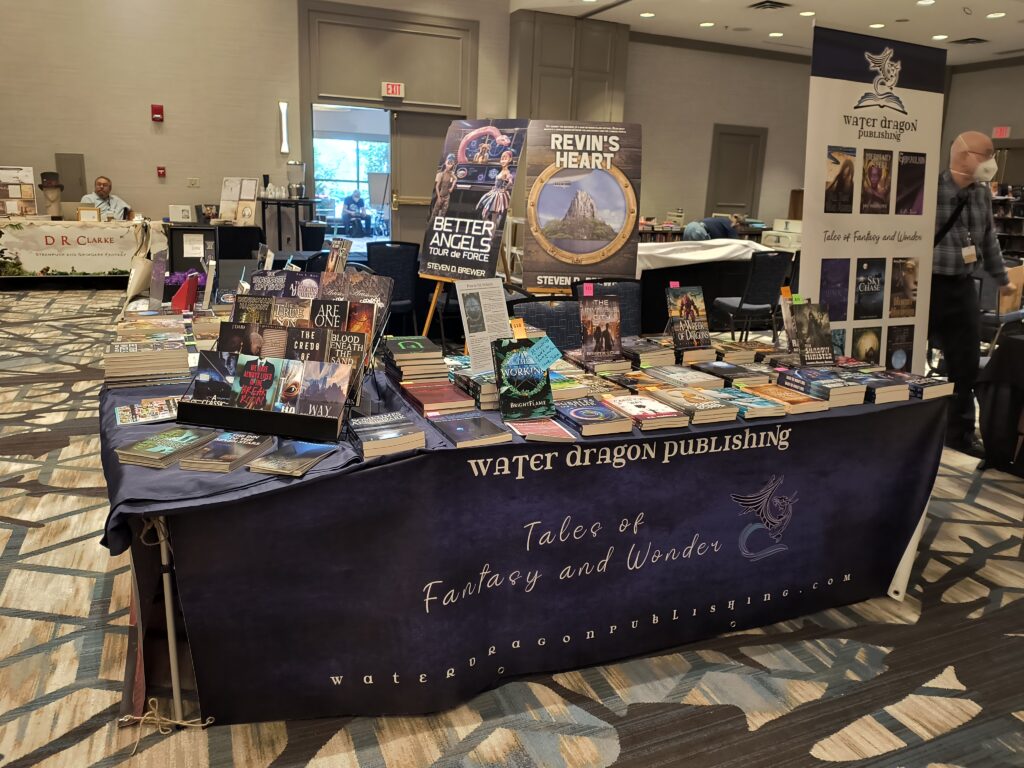
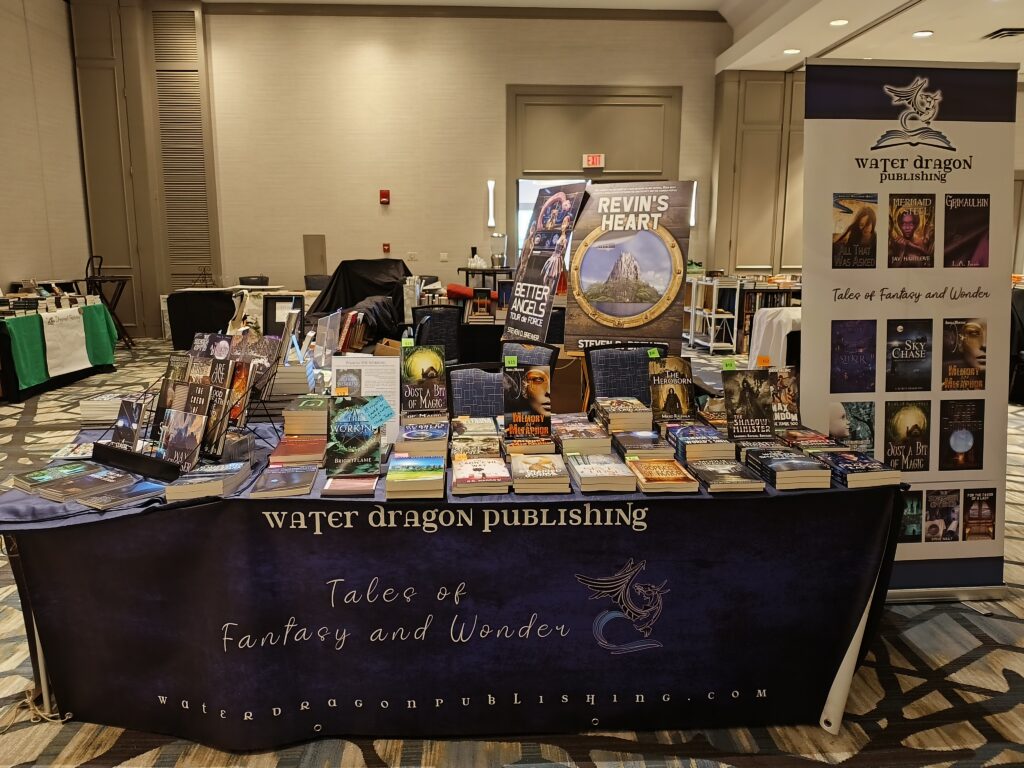
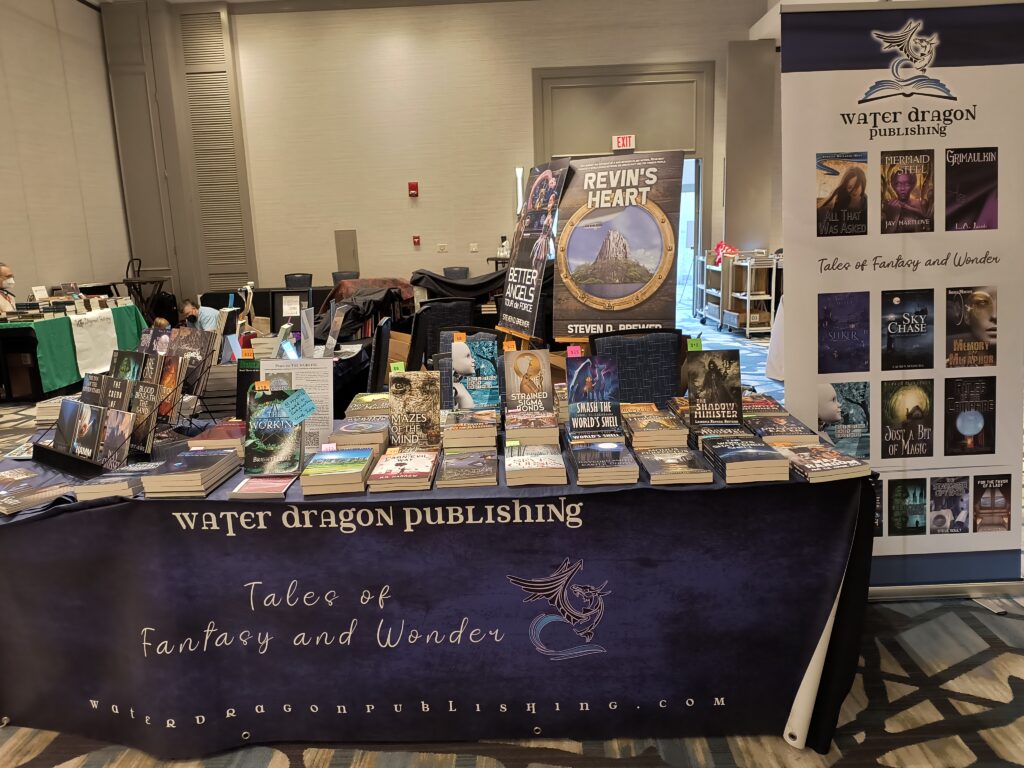
Three authors, besides me, were available to represent our table: two other Water Dragon authors and one SPBU author. I tried to spread the books by different authors out around the tables so that there was a chair where each of the books was positioned so that the author could stand behind their book to sell it. I was pleased when someone was looking at an author’s book when the author was near the table. I was able to point the author out for them to ask a question which then led to a sale. It’s amazing what a difference it makes to be present for selling books. In point of fact, reaching out to people when they’re at the table to call attention to your books makes a huge difference as well. At least half of my sales — maybe more — are directly attributable to my reaching out to people at the table to pitch books. If your books are just “there” people are much less likely to notice them.
One thing that surprised me this year was who I didn’t see in the bookstore. I’ve often enjoyed being in the bookstore because it’s an opportunity to see everyone that comes through. But not everyone visited the bookstore at Readercon this year. I might not have noticed, but I was particularly struck because a number of the most prominent, instantly-recognizable, authors and other members of the SFF community never came into the bookstore at all, which I found personally disappointing. At some other conventions, there are a number of inducements or other activities planned associated with the bookstore (or “dealer room”) that encourage people to visit. Maybe something like that would help here.
I got to pilot-test the 任せて DNA Analysis tool and Human DNA ribbon. Readercon only started using ribbons last year and there is not a strong ribbon culture. I developed a pitch centered around the tool that I introduced occasionally after my usual pitch. It was sometimes effective. Nobody seemed to find it problematic. A few people independently noticed the QR code irrespective of the pitch. (Or actually codes because I actually had two: one that led to the “Book” page of my website.) Although it didn’t seem interesting to everyone, some people really loved it. I still need to work a bit on the follow-up mini lecture about the human genome, to tighten it up and to bring it back more effectively to sell the book.
Rock, Roll, and Gather at Look Park



On Saturday, August 2, 2025, the Stavros Center For Independent Living is hosting the Rock, Roll & Gather Maker’s Market at Look Park in celebration of the Americans with Disabilities Act. As someone with a disability, I’m pleased to participate and sell books for Water Dragon Publishing.
I’ll bring my own books plus a selection of other books from Water Dragon. The weather looks spectacular and I hope we’ll have a great showing. I hope to see you there!